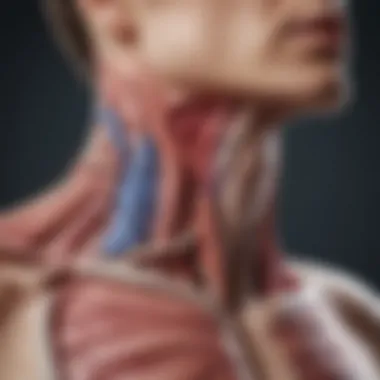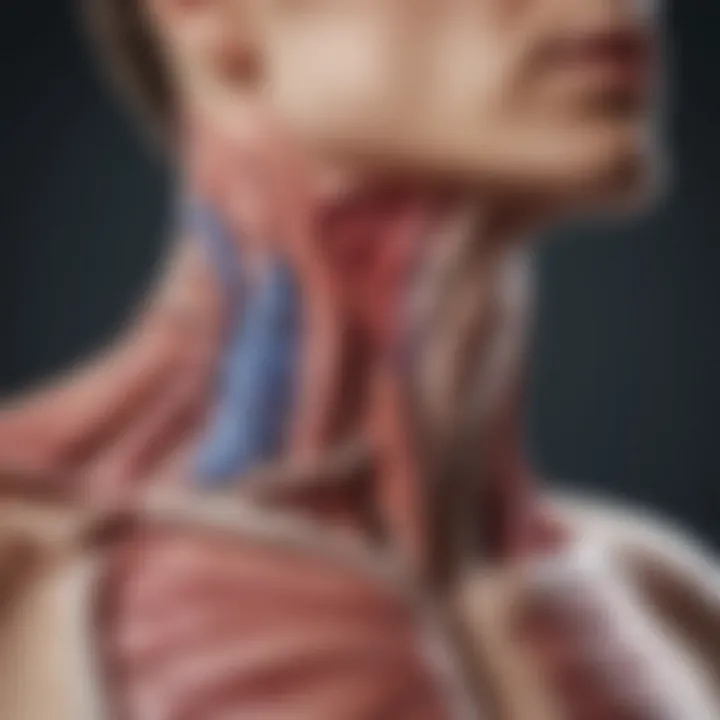Understanding Esophageal Pain: Causes and Treatments


Intro
Pain in the esophagus can be alarming, and it is a symptom that many people experience at some point in their lives. Understanding the causes, symptoms, and treatment options for esophageal pain is crucial for both patients and healthcare providers. This article delves into the intricacies surrounding esophageal pain, aiming to demystify its complexities and promote a deeper understanding.
When we discuss esophageal pain, we refer to discomfort or a painful sensation that occurs in the tube connecting the throat to the stomach. While some may dismiss it as merely heartburn or indigestion, esophageal pain can be linked to various medical conditions ranging from very mild to potentially serious. Therefore, identifying the underlying causes becomes essential to determine the appropriate management and treatment. The significance of seeking medical advice cannot be stressed enough; symptoms that may seem trivial at first glance sometimes indicate more severe issues needing intervention.
By evaluating this multifaceted subject, the intention is to highlight not only the various causes and symptoms but also the practical treatment options available, empowering readers with knowledge. It's vital to appreciate that pain in the esophagus is not isolated to just one condition, but rather signifies a myriad of potential ailments, each with its own unique treatment pathway.
Armed with this insight, readers will better understand the importance of paying attention to their symptoms, knowing when to consult a healthcare professional, and taking proactive steps toward effective management. This article serves as a comprehensive guide, aiming to encourage informed discussions and decisions about esophageal health.
Foreword to Esophageal Pain
Esophageal pain is an issue that affects many people, yet it's often misunderstood. Awareness of what causes this pain, how to recognize it, and what treatment options exist is crucial for patients and healthcare providers alike. The esophagus, a muscular tube connecting the throat to the stomach, is vital in our digestion and overall health. Thus, when pain arises in this area, it can significantly impact one's quality of life.
Defining Esophageal Pain
Esophageal pain can present itself in many forms; it's not always just a sharp stabbing pain. Some individuals describe it as a burning sensation, similar to heartburn, while others may feel a heavy pressure, akin to something pressing down on their chest. This variety doesn’t merely complicate diagnosis but also underscores the complexity of esophageal conditions.
Patients may experience pain during swallowing, known as odynophagia, or may have difficulty swallowing altogether, referred to as dysphagia. Both symptoms can indicate an underlying disorder that needs to be examined closely. Understanding these definitions and types of pain will help individuals articulate their experiences more clearly to their healthcare providers, leading to a more effective examination and treatment process.
Significance of Understanding Symptoms
Understanding symptoms related to esophageal pain is not just academic; it holds real-life implications. When people know what to watch for, they are more likely to seek help sooner. For instance, difficulty swallowing or acute chest pain shouldn’t be brushed off as trivial. Persisting symptoms could indicate more serious issues, such as Gastroesophageal Reflux Disease or even esophageal cancer.
Identifying underlying causes is essential for appropriate treatment, which often requires a tailored approach. As with many medical conditions, early intervention can make a significant difference in prognosis. The ability to describe one’s symptoms accurately boosts the chances of receiving the right care in a timely manner.
"Recognizing clear symptoms in esophageal pain can turn a vague discomfort into focused action for healthier outcomes."
In this section, we’ve highlighted foundational concepts that pave the way for a deeper exploration of the causes and treatments of esophageal pain. Understanding these symptoms does not only enable individuals to express their medical concerns effectively but also increases awareness of their own health, which is critical for informed decision-making.
Possible Causes of Esophageal Pain
Understanding the various elements that contribute to esophageal pain is vital not just for healthcare providers, but also for anyone experiencing discomfort in this area. Identifying the causes aids in effective treatment planning and can significantly improve a patient's quality of life. Knowing whether pain is stemming from something benign or a more serious issue can help direct the appropriate interventions. Individuals often face challenges in distinguishing symptoms related to esophageal pain, which is why understanding these causes becomes crucial.
Gastroesophageal Reflux Disease (GERD)
GERD stands out as a leading cause of esophageal pain, characterized by the backward flow of stomach acids into the esophagus. This acid reflux can lead to a burning sensation known as heartburn, making it a common complaint among many.
There are several notable aspects of GERD:
- Symptoms often include persistent heartburn, regurgitation, and even chest pain.
- Risk Factors can range from obesity and a poor diet to smoking and high alcohol intake.
- Long-term Effects could potentially damage the lining of the esophagus, resulting in complications like Barrett's esophagus, a condition that can increase cancer risk.
Management often requires a combination of lifestyle modifications, dietary changes, and medications such as proton pump inhibitors, showing how strategic choices can lead to symptom relief.
Esophagitis
Esophagitis refers to inflammation of the esophagus, which can lead to considerable discomfort. This condition can arise from various sources.
- Irritants such as corrosive substances like alkaline cleaners can cause damage.
- Infections may stem from yeast or viral infections, affecting individuals with weakened immune systems.
- Allergens can also play a role, resulting in eosinophilic esophagitis – a condition that has gained attention in recent years.
The symptoms of esophagitis may include painful swallowing, chest pain, and the sensation of food getting stuck, which should prompt further evaluation.
Esophageal Spasms


Esophageal spasms represent another category of pain-generating events in the esophagus. These spasms lead to intermittent contractions that can disrupt normal swallowing and cause significant discomfort.
- Symptoms can manifest as severe chest pain, often confused with heart issues.
- Triggers may include hot or cold foods and even stress.
- In some cases, the exact cause remains elusive, complicating the management.
Treatment strategies may involve medications that relax esophageal muscles, along with lifestyle changes, to minimize discomfort.
Swallowing Disorders
Dysphagia or swallowing disorders lead to pain during the act of swallowing food or liquids. Various reasons can underlie these disorders, from structural changes in the esophagus to neurological conditions.
- Structural Causes could involve narrowing of the esophagus due to scar tissue or tumors.
- Neurological Factors include diseases like Parkinson’s that affect muscle coordination.
- Symptoms that patients often experience include pain while swallowing or the sensation of food getting lodged.
Addressing swallowing disorders typically requires a multimodal approach tailored to underlying causes, reinforcing the importance of thorough evaluation.
Infections and Other Conditions
Infections, while perhaps less common, can still contribute to esophageal pain. Conditions such as Candida esophagitis result from fungal infections and are often seen in people with compromised immune systems.
- Other Infections might include viral infections from herpes simplex or cytomegalovirus.
- Beyond infections, conditions like cancer or even chest trauma can lead to pain that radiates to the esophagus.
- These scenarios emphasize the need for healthcare professionals to keep a broad differential diagnosis in mind when assessing esophageal pain.
Recognizing Symptoms of Esophageal Pain
Understanding the symptoms of esophageal pain is crucial for early detection and effective management of underlying issues. Not only does it assist healthcare providers in diagnosing conditions, but it also empowers individuals to recognize when their discomfort warrants intervention. Symptoms can often provide a window into one's overall health, indicating potential problems that may not at first glance seem related to the esophagus.
Common Symptoms Explained
The symptoms associated with esophageal pain can vary widely from person to person. Some of the most common symptoms include:
- Heartburn: A burning sensation that may travel from the stomach to the chest, often exacerbated after eating.
- Difficulty swallowing: Also known as dysphagia, this can manifest as a feeling of food getting stuck or discomfort while swallowing.
- Chest pain: While it can be associated with heart-related issues, esophageal pain can also present as pain in the chest area, which might mimic heart conditions.
- Sore throat or hoarseness: These symptoms may arise when acid reflux irritates the throat or vocal cords.
- Regurgitation: The sensation of stomach contents rising back into the throat or mouth, often accompanied by an unpleasant taste.
Beyond these symptoms, it’s important to note that esophageal pain can be a precursor to more severe conditions, making awareness imperative. Each of these symptoms serves a purpose in indicating what might be going wrong, and understanding them can significantly influence an individual's response to the pain they are experiencing.
When to Seek Medical Help
Knowing when to get medical help can make a world of difference. Individuals should seek medical advice if they experience:
- Persistent pain: If symptoms last longer than a few days, especially if pain escalates.
- Severe symptoms: Sudden, intense pain accompanied by nausea, vomiting, or sweating could signal something serious.
- Unexplained weight loss: Losing weight unexpectedly could indicate an underlying issue that requires attention.
- Blood in vomit or stools: This necessitates immediate medical evaluation as it may indicate bleeding in the esophagus.
Early recognition of these symptoms can lead to timely diagnosis and treatment, potentially preventing more serious health complications.
Overall, being cognizant of how esophageal pain manifests allows individuals to act promptly, ensuring a better chance of addressing potential health conditions before they worsen. Taking charge of one's health by recognizing symptoms can lead to healthier outcomes and improved quality of life.
Diagnostic Approaches for Esophageal Pain
Understanding the diagnostic approaches for esophageal pain is paramount for accurately identifying the underlying causes. With various medical conditions manifesting through similar pain, a systematic evaluation is critical to avoid misdiagnosis and inappropriate treatment. Effective diagnostics not only help in pinpointing the source of discomfort but also guide subsequent therapeutic interventions. Choosing the right method depends on patient history, symptom severity, and other clinical indications, leading to optimal outcomes.
Initial Evaluation and History Taking
The first step in diagnosing esophageal pain typically involves a thorough evaluation and taking a detailed medical history. This process allows healthcare professionals to gather pertinent information that may hint at the cause of the pain. Questions surrounding the patient’s symptoms are critical. Does the pain occur while swallowing? Are there associated symptoms like heartburn or regurgitation? Moreover, understanding any previous medical conditions and therapies the patient has undergone provides context.
Asking about dietary habits and lifestyle factors, such as smoking and alcohol consumption, may also shed light on potential contributors. Every detail counts, because, in the case of esophageal problems, a slight variance can turn the diagnostic tide. It’s akin to piecing together a puzzle where each piece holds significance.
Endoscopic Procedures
Endoscopy is a cornerstone in diagnosing esophageal pain, allowing direct visualization of the esophagus. This procedure involves using a flexible tube with a camera, inserted through the throat, to examine the lining of the esophagus for abnormalities. These can range from inflammation to tumors, not to mention ulcers, which might be causing pain. The ability to take biopsies during the procedure further enhances diagnostics if suspicious lesions are found.


While this method might make some patients squeamish, it offers invaluable insights. As the old saying goes, "seeing is believing," and in this case, seeing direct findings ensures an accurate diagnosis, preventing unnecessary worry or mismanagement of treatment.
Imaging Techniques
In addition to endoscopy, imaging techniques play a vital role in the diagnostic process. Methods like X-rays and CT scans aid in visualizing the overall anatomy of the esophagus as well as adjacent structures. Barium swallow studies can be particularly enlightening, as they involve the patient swallowing a barium solution that highlights the esophagus in X-ray images. Afterward, this can reveal issues with structure or motility, adding layers of understanding to the clinical picture.
Nevertheless, imaging is not a one-size-fits-all solution. Its use depends on specific indications and prior findings, thus necessitating a tailored approach based on individual patient assessment.
Functional Tests
Functional tests are yet another tool in the diagnostic toolkit, focusing primarily on how well the esophagus is performing its duties. Esophageal manometry is one such test, measuring the strength and coordination of esophageal muscles during swallowing. This can highlight issues with motility, which might explain pain symptoms. Another noteworthy test includes the pH monitoring procedure, which assesses the acid levels in the esophagus over a 24-hour period. Elevated acid levels can signal conditions like GERD, confirming suspicions raised during history-taking or symptom evaluation.
These functional tests, while a bit technical, provide a thorough exploration of esophageal function. They help in confirming diagnoses that imaging might not clarify, thus adding depth and accuracy to the clinical picture.
"A correct diagnosis can not only alleviate pain but also significantly improve a patient's quality of life."
Treatment Options for Esophageal Pain
The significance of treatment options for esophageal pain cannot be overstated. Understanding and addressing the causes of this discomfort is crucial for improving quality of life. Different strategies exist, each tailored to the underlying issues, patient preferences, and severity of symptoms. Implementing a multi-faceted approach not only alleviates immediate pain but also enhances long-term health outcomes.
Lifestyle Modifications
Lifestyle changes can be a game-changer when it comes to managing esophageal pain. Adopting healthier habits may significantly reduce symptom frequency and intensity. Here are some practical adjustments patients might consider:
- Dietary Choices: Avoiding trigger foods, such as spicy dishes, citrus fruits, and carbonated beverages, can have a direct impact on reducing symptoms. A balanced diet with low fat and high fiber contents promotes digestive health.
- Meal Timing: Eating small, frequent meals instead of three large ones helps to decrease pressure on the esophagus. Additionally, it's advisable to refrain from lying down immediately after feeling full, allowing gravity to do its work.
- Weight Management: Maintaining a healthy weight can lower the risks associated with conditions like GERD, which is closely linked to esophageal pain.
- Posture Considerations: Engaging in proper posture while sitting and standing can help facilitate easier swallowing and reduce discomfort.
By creating awareness and fostering behavioral changes, patients can often take a proactive stance in managing their esophageal pain.
Medications
Medications play a vital role in treating esophageal pain, especially when lifestyle modifications alone do not provide sufficient relief. Various types of medications are available, each targeting different symptoms and underlying causes:
- Proton Pump Inhibitors (PPIs): Drugs like omeprazole and esomeprazole are commonly prescribed to reduce stomach acid production, thereby alleviating pain induced by acid reflux.
- Antacids: These over-the-counter medications neutralize stomach acid quickly, providing short-term relief for heartburn and mild esophageal pain.
- ** Receptor Antagonists**: Ranitidine and famotidine belong to this category and can help decrease acid production, though they are often not as potent as PPIs.
- Muscle Relaxants: In cases of esophageal spasms, muscle relaxants may help ease this discomfort by relaxing the muscles of the esophagus.
Adhering to prescribed medication regimens and consulting healthcare providers about drug interactions or side effects is essential for effective management.
Surgical Interventions
In more severe cases of esophageal pain, conservative treatments may not suffice, leading to discussions about surgical options. Here are a few surgical interventions that might be considered:
- Fundoplication: This common surgery involves wrapping the top of the stomach around the lower esophagus to prevent acid reflux. It's often a recommendation for patients with severe GERD when medications aren’t effective.
- Dilation: For those suffering from strictures or narrowing of the esophagus, a dilation procedure can widen the esophagus, allowing for easier passage of food and reducing pain.
- Esophagectomy: This is a more drastic approach, involving the partial or complete removal of the esophagus. It's reserved for serious conditions, such as cancer or severe dysmotility.
Surgery can be beneficial for some patients but comes with its own set of risks and considerations. Thorough discussions with healthcare professionals about the best options based on individual circumstances remain imperative.
The treatment of esophageal pain necessitates a tailored approach harmonizing lifestyle adjustments, medications, and, when appropriate, surgical interventions. Such comprehensive management can lead to significant improvements in patient experiences.
Long-Term Management of Esophageal Pain
Managing esophageal pain over the long haul requires a multidimensional approach. It's not merely about diagnosing the acute symptoms or treating them with medications that can sometimes feel like a band-aid fix. This section highlights the importance of consistent follow-up care and the incorporation of dietary adjustments into a comprehensive management strategy. By understanding these facets, patients can navigate their pain with more confidence and foresight.
Importance of Follow-Up Care
Follow-up care post-diagnosis plays a crucial role in the management of esophageal pain. It allows healthcare providers to monitor the effectiveness of treatments, making necessary adjustments, and identifying any new concerns that may arise. Regular check-ups can also help in preventing potential complications.


- Continuity of care leads to better health outcomes, as medical professionals can uncover patterns in how esophageal pain affects the patient over time.
- Active communication during these visits can enlighten both patients and providers about treatment efficacy, side effects, and quality of life improvements.
- It fosters a dynamic where patients feel empowered to share their experiences, potentially leading to customized care plans.
It's essential for patients to understand that esophageal pain can change. Regular follow-ups serve as a reminder that medical conditions are often not static, needing adjustments along the way.
Integrating Dietary Changes
Dietary choices can be tremendously impactful when it comes to managing esophageal pain. What one consumes can either exacerbate discomfort or soothe the symptoms. Here are some key elements to consider when making dietary changes:
- Identifying Triggers: Every individual reacts differently to various foods. Keeping a food diary may help pinpoint triggers that exacerbate esophageal pain. Common culprits often include spicy foods, citrus fruits, and high-fat meals.
- Creating a Balanced Diet: Integrating fiber-rich foods, lean proteins, and plenty of fruits and vegetables could enhance digestive health. A well-rounded diet supports overall well-being, benefiting not just the esophagus but also the body as a whole.
- Hydration: Drinking enough fluids can aid in digestion and help mitigate some discomfort. Opting for water over carbonated beverages often proves beneficial.
"Many aspects of diet are simple in theory but complex in practice. Fine-tuning one's approach can transform symptom management over time."
Over time, these dietary changes can lead to considerable improvements in symptoms. Patients may find themselves better equipped to handle the unique challenges posed by their condition.
Long-term management is not just about treating symptoms; it’s about fostering a lifestyle conducive to healing and comfort. By establishing a solid follow-up care regimen and actively engaging in dietary modifications, individuals can transform their experiences with esophageal pain into manageable journeys.
Emerging Trends in Research
Research regarding esophageal pain is witnessing a notable evolution, highlighting innovative pathways to understanding and managing various disorders. As health professionals and researchers alike aim to effectively tackle the complexities surrounding esophageal ailments, several key themes are emerging. By exploring these trends, we not only deepen our knowledge but also improve treatment outcomes and quality of life for those affected.
Current Studies on Esophageal Disorders
Recent studies are placing significant emphasis on the biological mechanisms behind esophageal pain. For instance, research reveals how changes in esophageal motility can contribute to discomfort. Investigations involving the esophageal microbiome are becoming more common, shedding light on how the diverse bacteria within the esophagus influence its health and function.
Moreover, multicenter trials are focusing on the effectiveness of various diagnostic approaches. These include trials assessing the accuracy of endoscopic technologies and advanced imaging techniques like high-resolution manometry. These efforts provide solid data supporting evolving practices in the identification of esophageal disorders, which can dramatically enhance diagnostic accuracy.
In addition, researchers are studying the correlation between psychological factors and esophageal pain, such as depression and anxiety, often seen in patients. Understanding these interconnections could lead to more holistic treatment strategies that encompass both physical and mental health needs.
Innovative Approaches to Treatment
The frontiers of treatment options are being broadened with the introduction of personalized medicine in managing esophageal pain. Through genetic profiling and biomarker analysis, healthcare providers are now equipped to tailor treatments to individual patients' profiles. This approach not only promises enhanced effectiveness but also minimizes the chances of adverse reactions.
Furthermore, non-pharmacological strategies are gaining traction. Cognitive behavioral therapy (CBT) has shown promising results in managing pain and improving coping mechanisms for patients. This method recognizes the significant role of the mind in experiencing physical discomfort.
Emerging technologies are equally pivotal. Novel devices for real-time monitoring of esophageal conditions are being designed, providing accurate, continuous data that can lead to timely interventions. Some studies also explore the use of neuromodulation technologies as potential therapeutic avenues to alleviate esophageal pain.
"The integration of innovative technologies and personalized approaches represents a groundbreaking shift in managing esophageal disorders, paving the way for more effective treatments and enhanced patient care."
By staying abreast of these emerging trends and studies, we can foster a deeper understanding of esophageal disorders and take significant strides towards improving treatment modalities.
Culmination
The exploration of esophageal pain reveals a multifaceted issue that requires careful consideration from both medical and patient perspectives. Understanding the causes, symptoms, and treatment options not only empowers patients but also enriches the knowledge of healthcare providers. It underscores the need to remain vigilant about health issues that may initially seem trivial but can signal underlying medical conditions. Moreover, this knowledge fosters a proactive approach to health management, enabling individuals to make informed choices about their well-being.
Summarizing Key Points
In this article, we have highlighted key elements that contribute to the understanding of esophageal pain:
- Defining and recognizing esophageal pain is essential—knowledge of both common and atypical symptoms can facilitate early diagnosis and intervention.
- Diverse causes such as GERD, esophagitis, and other esophageal disorders are intricately linked to the discomfort experienced by patients. Each condition presents unique challenges that vary from acute to chronic.
- Diagnostic methods encompass a range from simple evaluations to advanced imaging techniques, emphasizing the importance of a thorough assessment to pinpoint the exact cause of pain.
- Treatment options vary widely, necessitating personalized approaches that include lifestyle modifications, medications, and sometimes surgical interventions.
- Long-term management strategies are crucial, as they focus on maintaining health, preventing future occurrences, and ensuring a better quality of life.
These points collectively provide a framework for understanding not only the esophageal pain itself but also the broader implications it may have on an individual's health and life.
Future Directions in Research and Treatment
As our comprehension of esophageal disorders evolves, there are several avenues for future research and therapeutic innovations:
- Investigating underlying mechanisms of esophageal pain can help address the gap in understanding why certain patients experience more severe symptoms than others. This could lead to more targeted treatment approaches.
- Exploring the role of diet in managing esophageal conditions deserves attention, as dietary habits can significantly impact symptoms. Clinical trials focusing on specific dietary modifications might yield promising results.
- Advancements in imaging techniques could further refine diagnostic processes, making it easier to identify esophageal disorders at earlier stages.
- Patient-centered care models are gaining traction, emphasizing the importance of involving patients in their treatment plans and understanding their unique responses to therapy.
"As we unravel the complexities of esophageal disorders, each step forward opens doors to better patient care and understanding."
Addressing esophageal pain effectively requires ongoing research to refine treatments and enhance the overall understanding of the conditions affecting this vital part of the digestive system. The commitment to exploring innovative approaches will not only benefit patients but also enrich the field of gastroenterology.



